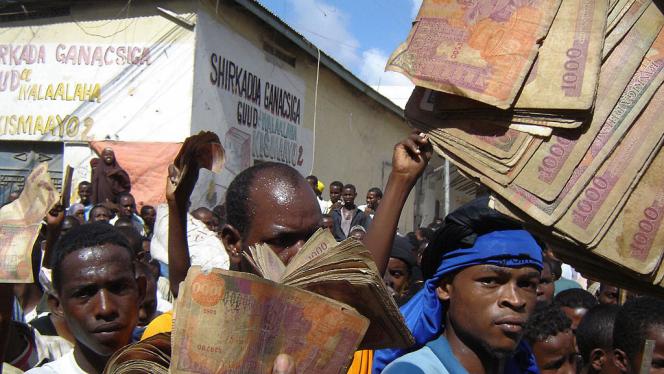Thursday 21 November 2024
What is the IMF’s plan for reviving the Somali shilling?

Somalia’s attempt to revive the Shilling might help address the economy’s dollarisation, but the terms of its revival with IMF and World Bank support come with their own risks.
Since the collapse of the central government in 1991 and the subsequent loss of confidence in the local currency, the Shilling, which is now printed by companies and individuals in arbitrary denominations, the phenomenon of dollarisation has prevailed in Somalia. For the last three decades, the currency has largely operated without a central bank or monetary authority to guarantee its value. Although The Economist hailed it as “Hard to Kill,” dollarisation poses new risks.
Dollarisation is a global issue varying causes from country to country, including high inflation, loss of confidence in the currency, failure of interest rates to achieve a positive return, political crises, and institutional collapse.
To address this issue in Somalia, the International Monetary Fund (IMF) proposed a plan to revive the local currency, the Somali Shilling (SOS), in its first review report of the Extended Credit Facility (ECF) program, worth $100 million for Somalia. What are the details of this plan, and what conditions are required to achieve it?
Reviving the Somali Shilling
Supported by the World Bank, which provides part of the international grants to finance the plan, the IMF is working with the federal government to revive the Shilling. This includes replacing old and counterfeit banknotes in circulation and issuing new notes labelled with the Shilling, alongside legislative reforms and financial support. Dollarisation has made the dollar a semi-official currency in Somalia, where it performs basic monetary functions such as valuing goods, paying wages, and facilitating trade. Although not the official currency, the dollar is used in nearly all government financial transactions.
An important measure to estimate the level of dollarisation is calculating the volume of dollar deposits compared to local currency deposits. However, in Somalia, there are no financial deposits in banks in the local currency, while there are deposits worth $1.2 billion in hard currency, with a similar amount in electronic money wallets.
The plan to revive the Shilling is based on several requirements. Firstly, setting exchange rate and monetary policy frameworks. These frameworks should provide a stable and predictable political environment to build confidence in the national currency across the country, enhance the credibility of the Central Bank of Somalia (CBS), and develop the local financial market.
Secondly, setting local currency prices according to the Currency Board Arrangements system (CBA), which involves pegging the issuance of the Shilling to a foreign currency, likely the dollar. The board would control the issuance of money based on foreign currency reserves, preventing the misuse of these reserves to avoid devaluing the local currency.
Thirdly, setting policies and reforms to ensure financial discipline, financial sustainability, and the independence of the central bank. This involves enhancing its regulatory and supervisory capacities, ensuring transparency, building the capacity of financial institutions, and improving the quality of macroeconomic and financial data.
The fourth requirement is providing sufficient financial guarantees to replace the old monetary block of Shillings, which is estimated to be between 1 trillion and 1.5 trillion Shillings, equivalent to about $40.9 to $61.8 million. Notably, a significant portion of these notes were printed by unauthorised companies and individuals, making them counterfeit, as the Central Bank of Somalia has not issued banknotes since 1991. It is a remarkable feature of Somalia’s economy that anyone retains confidence in the currency given a “paper currency is normally taken to be an expression of faith in the government that issues it.”
Political and financial challenges
The federal government has acknowledged, according to the report, the advantages of implementing the Currency Board Arrangement as a framework for determining the exchange rate. However, it has tied the final decision on the currency pricing system to the results of negotiations with stakeholders from federal state governments. Meanwhile, the IMF estimates the plan will cost about $72 million, with the World Bank providing around $40 million in grant funding, and Somalia negotiating with bilateral partners to cover the remaining $32 million. The implementation of the plan is expected to take 18 to 24 months, depending on factors such as “securing external funding and reaching a fixed agreement between the federal government and state governments”.
The IMF has pledged to reconsider increasing the Extended Credit Facility arrangement, currently set at $100 million, during the program review following the approval of the new currency plan. This is intended to support the federal government with a new concessional loan to boost confidence in the currency. The World Bank will design and print the new banknotes, manage the currency exchange (replacing old notes), build the central bank’s capacity, and oversee the project, which aims solely to replace the circulating stock of banknotes without expanding the monetary base or replacing the US dollar.
However, the plan faces several challenges, including a lack of public trust in government financial institutions and the widespread use of mobile electronic wallets, which reduces the demand for local banknotes. It is worth noting that this plan is not new; the Central Bank developed a roadmap for currency reform in 2016, with technical assistance from the IMF. The roadmap outlined key steps for currency reform, including combating counterfeiting, enhancing accounting and reporting units, defining the scope of exchange and transfer, and establishing facilities for storage, distribution, collection, nullification, and destruction. Additionally, it included building the legal framework and identifying accountability elements.
Advantages and disadvantages
In promoting its plan based on the Currency Board Arrangement, the IMF report highlighted several advantages. These include the stability of the new currency tied to a foreign currency, preserving its value (excluding dollar deposits in commercial banks), simplicity, transparency, and suitability for the limited operational resources and capabilities of the Central Bank of Somalia. The Currency Board Arrangement also maintains low inflation levels due to the stable exchange rate, encourages foreign investment due to the stable local currency, and facilitates easy profit transfer abroad. Currently, about 11 countries use the Currency Board Arrangement, including Djibouti (currency pegged to the dollar) and Bulgaria (currency pegged to the euro), with variations in implementation among these countries.
However, this system has its drawbacks. The central bank is unable to create local credit (provide funds to the government), lend to the government, or act as a lender of last resort (LOLR) because it is not authorised to issue currency or provide loans to the government and economy during crises. Additionally, the local currency is affected by the foreign currency it is pegged to, often the US dollar or the euro. This means the government cannot influence the interest rate, which will follow the US dollar rate despite different economic conditions, impacting the Shilling based on the dollar rather than Somalia's economic needs.
Moreover, Somalia does not have other alternatives to revive the Shilling, as citizens will not accept a local currency that is not backed by the dollar, which is widely used for everything. Therefore, the federal government must continue financial and economic reforms, build trust in financial institutions, and increase local revenues before working on reviving the Shilling. Additionally, issuing new Shilling banknotes requires the Central Bank to hold foreign currency reserves, with a direct relationship between the availability of foreign currency and the issuance of equivalent local banknotes. In this system, the bank's (Currency Board) profits come from the interest on foreign reserve investments, which must be low-risk investments.
In conclusion, if the federal government adopts the Currency Board Arrangement, it will ensure the issuance of a stable-value Shilling, but it will lose the ability to expand the monetary base required for development plans. Therefore, the timing may not yet be suitable for reviving the Shilling.










